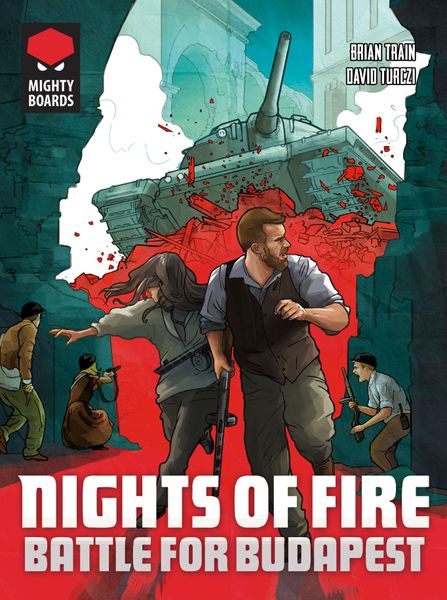Nights of Fire: Battle for Budapest (2019) Board Game
Brief History and Background Information for Nights of Fire: Battle for Budapest
Nights of Fire: Battle for Budapest is a board game that takes place during the Hungarian Revolution of 1956. Players take on the roles of Soviet troops or Hungarian rebels, battling it out in the streets of Budapest. This game is a sequel to the popular game Days of Ire: Budapest 1956, and offers a unique gaming experience with its card-driven mechanics.
Game Components of Nights of Fire: Battle for Budapest
- Game board
- Player boards
- Cards
- Tokens
- Dice
How To Setup Nights of Fire: Battle for Budapest
- Set up the game board in the center of the table.
- Each player chooses a side to play as – Soviet troops or Hungarian rebels.
- Place the tokens and cards in their designated areas.
- Shuffle the deck of cards and deal a starting hand to each player.
Gameplay Mechanics and Game Objective
The gameplay of Nights of Fire: Battle for Budapest revolves around area movement, cooperative gameplay, dice rolling, and hand management. Players must strategically move their units around the board, completing objectives and battling opponents. The main objective of the game is to control key areas of Budapest and achieve victory before the opposing side.
Player Experience
Pros:
- Engaging theme and historical setting
- Strategic gameplay with a good mix of luck and skill
- Cooperative elements make it a great game for teamwork
Cons:
- Rules may be complex for new players
- Limited replayability once you’ve mastered the strategies
- Some components could be of higher quality
Personal Thoughts on Nights of Fire: Battle for Budapest
Nights of Fire: Battle for Budapest is a unique and immersive game that offers a fresh take on the Hungarian Revolution. The build quality of the game is decent, but some components could be improved. Pricing and availability of the game may vary, but it’s worth checking out for fans of card games, modern warfare, and political themes. Alternatives and similar games include Twilight Struggle and Labyrinth: The War on Terror. Overall, Nights of Fire: Battle for Budapest is a game worth your time if you enjoy historical themes and strategic gameplay. It’s suitable for players who enjoy a challenge and can be skipped by those looking for a more casual gaming experience.
Game Components of Nights of Fire: Battle for Budapest
How To Setup Nights of Fire: Battle for Budapest
Setting up the game involves preparing the game board, shuffling and dealing the respective card decks, and placing the wooden blocks and tokens according to the initial setup rules. The rulebook and player aids provide detailed instructions for each phase of setup, ensuring that players can easily follow along. The setup is random, which adds to the game’s replayability.
Gameplay Mechanics and Game Objective
Player Experience
**Nights of Fire: Battle for Budapest** offers a dynamic and challenging experience, blending the tactical depth of wargames with the engagement of modern board game mechanics. Players must manage resources carefully, as the game’s outcome is heavily influenced by the cards drawn and the strategies employed. The game is designed to be easy to learn but challenging to master, with random setup ensuring that each playthrough is unique.
Pros
Cons
Personal Thoughts on Nights of Fire: Battle for Budapest
**Nights of Fire: Battle for Budapest** is ideal for players who enjoy strategic depth and historical themes. It is particularly suited for those interested in wargames but also appreciate the accessibility and engagement of modern board games. The game’s ability to cater to different player counts and its inclusion of solo and cooperative modes make it a versatile addition to any board game collection. However, due to its complexity and historical imbalance, it may not be the best fit for casual players seeking a quick, lighthearted experience.
We are supported by our audience. When you purchase through links on our site, we may earn an affiliate commission, at no extra cost for you. Learn more.

